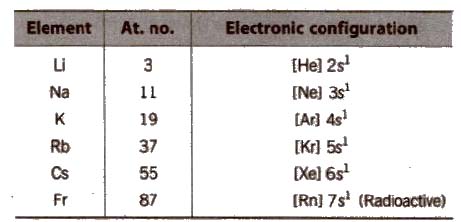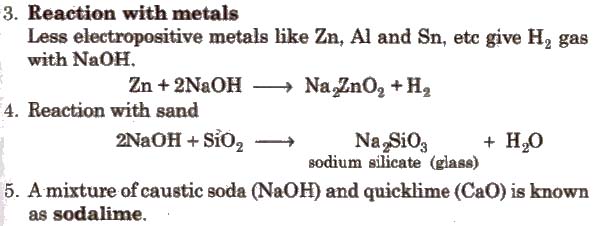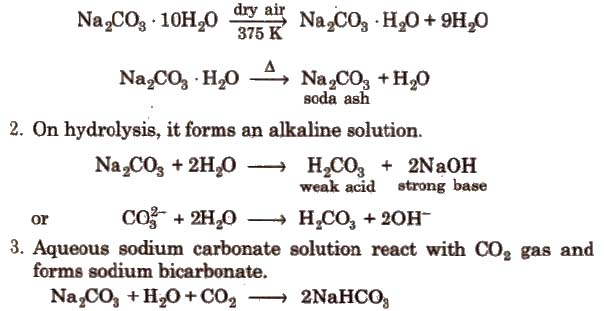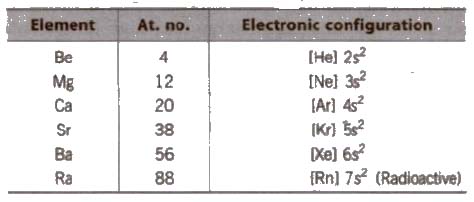





In the s-block elements the last electron enters in the s-orbital.
As the s-orbital can accommodate only two electrons, two groups (1 and 2) belong to the s-block,
The general electronic configuration of s-block elements is nsl or 2
Alkali Metals [Group-I]
Group-I elements have one electron in their valence shell. They do not occur in the native or free state. These elements are collectively known as alkali metals because their oxides and hydroxides form strong alkalies like NaOH, KOH, etc. Lithium is known as bridge element.
General Characteristics of Alkali Metals
(i) Electronic configuration [noble gas] ns1

(ii) Atomic radii The alkali metals have the biggest atomic radii in their respective periods.
Atomic radii increases as we go down the group due to the addition of a new shell in each subsequent step.
All of these have bee lattice with coordination number 4.
(iii) Ionic radii Ionic radii of the alkali metals are much smaller than their corresponding metals due to lesser number of shells and contractive effect of the increased nuclear charge.
The ionic radii of all these alkali metal ions go on increasing on moving down the group.
(iv) Density These are light metals with low densities. Lithium is the lightest known metal. On moving down the group, ‘density increases from Li to Cs.
This is because, down the group, both the atomic size and atomic mass increases but the effect of increase in atomic mass is more as compared to increase in atomic size.
The density of potassium is lesser than that of sodium because of the I abnormal increase in size on moving down from Na to K.
(v) Melting and boiling points
(vi) Softness These are soft. malleable and ductile solids which can be cut with knife. They possess metallic lustre when freshly cut due to oscillation of electrons.
(vii) Atomic volume Atomic volume of alkali metals is the highest in each period and goes on increasing down the group from top to bottom [Li to Cs].
(viii) Ionisation enthalpy The first ionisation enthalpy of alkali metals is the lowest amongst the elements in their respective periods and decreases on moving down the group.
The second ionisation enthalpies of all the alkali metals are very high because by releasing an electron, ions acquire noble gas configuration. so removal of second electron is difficult.
(ix) Electropositive character Due to low ionisation enthalpies. alkali metals are strongly electropositive or metallic in nature and electropositive nature increases from Li to Cs due to decrease in ionization enthalpy.
(x) Oxidation state The alkali metal atoms show only +1 oxidation state, because their unipositive ions attain the stable noble gas configuration.
The alkali metal ions attain noble gas configuration with no unpaired electrons so. they are diamagnetic in nature. Alkali metals however have paramagnetic nature due to one unpaired electron.
(xi) Hydration of ions The degree of hydration depends upon the size of the cation. Smaller the size of a cation. greater is its
hydration enthalpy
Relative degree of hydration,
Li+ > Na+ > K+ > Rb+ > Cs+
(xii) Flame colouration Alkali metals and their salts impart characteristic colours to the flame because the outer electrons get excited to higher energy levels, When the electron return to the original state. it releases visible light of characteristic wavelength which provides a colour to the flame.

(xiii) Photoelectric effect Due to very low ionisation enthalpy, alkali metals specially ‘Cs’ exhibit photoelectric effect ti.e., eject electrons
when exposed to light) so it is used in photoelectric cells.
(xiv) Electrical conductivity Due to the presence of loosely held valence electrons which are free to move throughout the metal structure. the alkali metals are good conductors of heat and electricity. Electrical conductivity increases from top to bottom in the order
Li+ < Na+ < K+ < Rb+ < Cs+
(xv) Reducing character All the alkali metals are good reducing agents due to their low ionisation energies. Their reducing character. follows the order
Na < K < Rb < Cs < Li
Chemical Properties of Alkali Metals
(i) Action of air On exposure to moist air, their surface get tarnished due to the formation of their oxides. hydroxides and carbonates.

Hence. they are kept under inert liquid like kerosene oil but lithium is kept wrapped in paraffin wax because it floats on the surface of kerosene oil due to its low density.
Note Fire due to alkali Metals is extinguished by CCI4
(ii) Action of oxygen
(a) All the alkali metals when heated with oxygen form different types of oxides. e.g., lithium forms lithium oxide (Li2O), sodium forms sodium peroxide (Na2O2), while K, Rb and Cs form superoxides MO2 (where, M = K, Rb or Cs)
The stability of peroxides and superoxides increases as the size of alkali metal increases.

(b) Superoxides are coloured and paramagnetic as these possess three electron bondwhere one unpaired electron is present.
(c) All oxides. peroxides and superoxides are basic in nature.
Basic strength of oxides increase in the order
Li2O < Na2O < K2O < Cs2O
Na2O2 acquires yellow colour due to the presence of superoxides as an impurity.
KO2 (potassium superoxide) is used as a source of oxygen in submarines, space shuttles and in emergency breathing apparatus such as oxygen masks.
(iii) Action of water or compounds containing acidic hydrogen
2M + 2H2O → 2MOH + H2 (where, M = Li, Na, K, Rb, and Cs)
The reactivity order with water is
Li < Na < K < Rb < Cs
This is due to increase in electropositive character in the same order.
KOH is stronger base than NaOH .
LiOH is used to remove carbon dioxide from exhaled air in confined quarters like submarines and space vehicles.
(iv) Action of hydrogen
2M + H2O → 2MH (where, M = Li, Na, K, Rb, and Cs)
The reactivity of alkali metals towards hydrogen is
Li > Na > K > Rb > Cs.
(v) Reaction with halogens Alkali metals combine readily with halogens to form ionic halides M+X- (with the exception of some lithium halides).
2M + X2 → 2M+ X– (where, M = Li, Na, K etc., and X = F, Cl, Br, 1]
The reactivity of alkali metals towards a particular halogen increase in the order
Li < Na < K < Rb < Cs For a given halide, ionic character increases as the size of metal ion increases. LiX > NaX < KX < RbX < CSX All alkali halides except LiF are freely soluble in water (LiF is soluble in non-polar solvents because it has strong covalent bond). LiCl is more covalent than KCI due to smaller size of Li. Bigger the anion, larger is its polarisability. Hence, the covalent character follow the order LiI > LiBr > LiCl > LiF
(vi) Solubility in liquid ammonia All alkali metals dissolve in liquid ammonia giving deep blue solution due to formation of ammoniated metal cations and ammoniated electrons in the solution.

The blue colour is due to the excitation of ammoniated electron to higher energy levels and the absorption of photons occurs in the red region of the spectrum.
This solution is highly conducting and paramagnetic because of the presence of ammoniated electrons and ammoniated cations.
(vii) Nature of carbonates and bicarbonates Li2CO3 is unstable toward heat.

The thermal stability of carbonates increases on moving down the group as

All the bicarbonates (except LiHCO3 which exists in solution) exist as solids and on heating form carbonates.

The solubility of the carbonates and bicarbonates increases on moving down the group due to decrease in lattice enthalpies. Thus, the order is
LiHCO3 < NaHCO3 <KHCO3 < RbHCO3 < CsHCO3
A mixture of Na2CO3 and K2CO3 is known as fusion mixture K2CO3is known as pearl ash.
(viii) Nature of nitrates LiNO3 on heating decomposes to give NO2 and O2, while the nitrates of the other alkali metals decompose on heating and give nitrites and O2.

NaNO3 is called chile saltpeter and KNO3 is called Indian saltpeter.
(ix) Nature of sulphates Li2SO4 is insoluble in water whereas the other sulphates, i:e., Na2SO4, K2SO4 are soluble in water.
Na2SO4 . 10H2O is called Glauber’s salt
Anomalous Behaviour of Lithium
Lithium shows anomalous behaviour due to the following reasons:
1. It has the smallest size in its group.
2. It has very high ionization enthalpy and highest electronegativity in the group.
3. Absence of d-orbitals inits valence shell.
As a result, it differs from the other alkali metals in the following properties :

Diagonal Relationship
Lithium shows diagonal resemblance with magnesium [the element of group 2] and this resemblance is due to similar polarising power, i.e.,
[ionic charge / (ionic radius)2] of both these elements.
Lithium resembles magnesium in the following respects :
Compounds of Sodium
1. Sodium Chloride, Common Salt or Table Salt [NaCI]
Sea water contains 2.7 to 2.9%by mass of the salt. Sodium chloride is obtained by evaporation of sea water but due to the presence of impurities like CaCl2 and MgCl2 it has deliquescens nature. It is purified by passing HCI gas through the impure saturated solution of
NaCl and due to common ion effect, pure NaCl gets precipitated. 28% NaCl solution is called brine.
2. Sodium Hydroxide or Caustic Soda [NaOH]
Methods of preparation
(i) A 10% solution of Na2CO3 is treated with milk of lime (Causticizing process).

(ii) Electrolytic process involves Nelson cell and Castner-Kellner cell.
A brine solution is electrolysed using a mercury cathode and a carbon anode. Sodium metal discharged at the cathode combines with Hg to form Na-amalgam. Chlorine gas is evolved at the anode.
The amalgam is treated with water to give sodium hydroxide and hydrogen gas.
2Na-Hg + 2H2O → 2NaOH + 2Hg + H2
Physical properties
Sodium hydroxide is a white translucent solid. It is readily soluble in water. Crystals of NaOH are deliquescent.
Chemical properties
1. It is a hygroscopic, deliquescent white solid, absorbs CO2 and moisture from the atmosphere


3. Sodium Carbonate or Washing Soda (Na2CO3 . 10H2O)
Solvay process
CO2 gas is passed through a brine solution saturated with NH3

Sodium bicarbonate is filtered and dried. It is ignited to give sodium carbonate.

Properties
1. Sodium carbonate crystallises from water as decahydrate which effloresces on exposure to dry air forming monohydrate which on heating change to anhydrous salt (soda-ash).

Uses
1. It is used in water softening, laundering and cleaning.
2. It is used in paper, paints and textile industries
4. Sodium Bicarbonate or Baking Soda (NaHCO3) Preparation
It is obtained as an intermediate product in Solvay process.
Properties

Uses
1. It is used as a constituent of baking powder which is a mixture of sodium bicarbonate, starch and potassium bitartrate or cream of tartar and in medicine to remove acidity of the stomach (as antacid).
2. NaHCO3 is a mild antiseptic for skin infections.
3 It is used in fire extinguisher.
5. Microcosmic salts [Na(NH4)HPO4 . 4H2O]
Preparation
It is prepared by dissolving Na2HPO4 and NH4Cl in the molecular proportions in hot water followed by crystallisation.

Properties
On heating it forms a transparent glassy bead of metaphosphate, which gives coloured beads of orthophosphates when heated with coloured salts like that of transition metal ions(Cu2+, Fe2+, Mn2+, Ni2+, CO2+).
This test is called microcosmic bead test.
Na(NH4) HPO4 → NH3 + H2O + NaPO3
sodium metaphosphate
CUSO4 → CuO + SO3
CuO + NaPO3 → CuNaPO4 (blue bead)
It is especially used to detect silica which being insoluble in NaPO3 gives a cloudy bead.
Alkaline Earth Metals [Group-ll]
Group-II elements are Be. Mg, Ca. Sr. Ba and Ra. which have two electrons in their valence shell. These are commonly called alkaline earth metals because their oxides are alkaline in nature and are found in earth’s crust.
Mg is present in chlorophyll and Ca is present in bones as calcium phosphate.
General Characteristics of Alkaline Earth Metals
(i) Electronic configuration [noble gas] ns2

(ii) Atomic radii and ionic radii The atomic radii and ionic radii of these clements are quite large but smaller than those of the corresponding alkali metals. due to increased nuclear charge of these elements. The atomic as well as ionic radii go on increasing down the group due to the gradual addition of extra energy level.
(iii) Density These are much denser than alkali meta Is because of their smaller size and greater nuclear charge and mass. The density. however. first decreases from Be to Ca and then steadily increases from Ca to Ra due to difference in type of crystal structure.
(iv) Melting and boiling points These metals have higher melting and boiling points than those of alkali metals because of greater number of bonding electrons.
The melting and boiling points decrease down the group with the exception of magnesium,
(v) Metallic properties These are silvery white metals. soft in nature but harder than alkali metals due to stronger metallic bonding.
(vi) Ionization enthalpy The first ionisation enthalpy of alkaline earth metals are higher than those of the corresponding alkali metals due to smaller size and ns2 configuration.
The second ionisation enthalpy values are higher than their first ionisation enthalpy values but much lower than the second ionisation enthalpy values of alkali metals.
On moving down the group. due to increase in atomic size, the magnitude of ionisation enthalpy decreases.
(vii) Electropositive character These are strong electropositive elements due to their large size and comparatively low ionisation enthalpy.
On moving down the group, the electropositive character increases due to increase in atomic radii and decrease in ionisation enthalpy.
(viii) Oxidation state Alkaline earth metals uniformly show an oxidation state of +2.
In the solid state, the dipositive ions (M2+) form strong lattices due to their small size and high charge (i.e., high lattice enthalpy).
[In the aqueous solution, the M2+ cations are strongly hydrated due to their small size and high charge. The hydration energy released by the M2+ cation is very high]
(ix) Flame colouration Alkaline earth metals salts impart characteristic colours to the flame.
As we move down the group from Ca to Ba, the ionisation enthalpy decreases, hence the energy or the frequency of the emitted light increases. Thus,

Be and Mg because of their high ionisation energies, do not impart any characteristic colour to the flame.
(x) Crystal lattice Be and Mg crystallise in hcp, Ca and Sr in ccp and Ba in bee lattice.
Chemical Properties of Alkaline Earth Metals
Alkaline earth elements are quite reactive due to their low ionisation energies but less reactive than alkali metals. Reactivity of the group.2
elements increases on moving down the group because their ionisation enthalpy decreases.
(i) Reaction with water Group-2 elements are less reactive with water as compared to alkali metals.
M + 2H2O → M(OH)2 + H2 (where, M = Mg, Ca, Sr or Ba)
Be does not react even with boiling water and Ba react vigorously even with cold water. Thus. increasing order of reactivity with water is
Mg < Ca < Sr < Ba
A suspension of Mg(OH)2 in water is called milk of magnesia.
Ca(OH)2 solution (lime water) and Ba(OH)2 solution (baryta are used for the detection of CO2,
(ii) Reaction with oxygen The affinity towards oxygen increases down the group. Thus. Be. Mg and Ca when heated with O2 form monoxides while Sr. Ba and Ra form peroxides.

(iii) Reaction with acids Alkaline earth metals except Be, displace H2 from acids.

Reactivity increases down the group from Mg to Ba. Only Mg displaces H2 from a very dilute HNO3.
(iv) Reaction with hydrogen Except Be, all other elements of group-2 combine with hydrogen on heating to form hydride (MH2).
M + H2 → MH2
BeH2 and MgH2 are covalent and polymeric whereas the hydrides of Ca, Sr and Ba are ionic in nature.
(v) Reaction with halogens All the elements of group-2 combine with halogens at high temperature, forming their corresponding halides (MX2).

Beryllium halides (BeF2, BeCI2, etc) are covalent, hygroscopic and fume in air due to hydrolysis, BeC12 exists as a dimer, The halides of other alkaline earth metals are fairly ionic and this character increases as the size of the metal increases.
The halides are soluble in water and their solubility decreases in the order
MgX2 > CaX2 > SrX2 > BaX2
(vi) Reaction with nitrogen These metals react with nitrogen to form nitrides of the types M3N2which are hydrolysed with water to evolve NH3.
3M + N2 → M3N2
M3N2 + 6H2O → 3M(OH)2 + 2NH3
(vii) Reaction with carbon These metals when heated with carbon, form their respective carbides of the general formula MC2 (except Be).

All these carbides are ionic in nature and react with H2O to form acetylene (except Be2C which gives methane).
CaC2 + 2H2 → Ca(OH)2 + HC = CH
(viii) Reducing character All the alkaline earth metals are strong reducing agents because of their lower electrode potentials but these are weaker than the corresponding alkali metals.
As we move down the group from Be to Ra, the reducing character increases due to decrease in ionisation enthalpy.
(ix) Solubility in liquid ammonia Like Alkali Metals, these metals also dissolve in liquid ammonia by giving coloured solutions.
M +(x+ y)NH3 [M(NH3)x]2+ + 2[e(NH3)y]–
The tendency to form ammoniates decreases with increase in size of the metal atom (i.e., on moving down the group).
(x) Complex formation It is favoured in case of alkaline earth metals because of their small sizes as compared to the alkali metals. Both Mg2+ and Ca2+ form six coordinate complexes with EDTA (ethylenediamminetetracetic acid) which are used to determine the hardness of water.
(xi) Basic strength of oxides and hydroxides BeO and Be(OH)2 are amphoteric while the oxides and hydroxides of other alkaline earth metals are basic. The basic strength, however, increases from Be to Ba.
The basic character of hydroxides of group – 2 elements is lesser than those of group-l hydroxides because of the larger size of later than former group.
(xii) Thermal stability and nature of bicarbonates and carbonates Bicarbonates of these metals do not exist in solid state but are known in solution only. When these solutions are heated, these get decomposed to evolve CO2.

The carbonates of alkaline earth metals can be regarded as salts of weak carbonic acid (H2CO3) and metal hydroxide, M(OH)2. The carbonates decompose on heating forming metal oxide and CO2.

Anomalous Behaviour of Beryllium
Beryllium, differs from the rest of the members of its group due to the following reasons
The points of difference are :
(i) Hardness Beryllium is denser and harder than other members of the family.
(ii) Melting point Beryllium has high melting point i.e., 1551 K while that of magnesium is 924 K
(iii) Ionisation potential It has higher ionisation potential as compared to the rest of the members of this group.
(iv) Reaction with acids Due to lower oxidation potential of Be, it does not liberate hydrogen from acids readily.
(v) Reaction with water Beryllium does not react with water even at higher temperature while other members of the family liberate hydrogen by reacting with water at room temperature.
(vi) Amphoteric in character Oxide (BeO) and hydroxide [Be(OH)2] of beryllium are amphoteric in character and dissolve in acids to form salt and beryUate in alkali.
(vii) Formation of carbides Beryllium when heated with carbon form Be2C which on reaction with water gives methane. While other members of the group form ionic carbide MC2 (acetylide) which on reaction with water evolve acetylene.
Diagonal Relationship Between Be and AI
The main identical physical and chemical properties of Be with aluminium are given below
(i) Action of air Both the metals are stable in air.
(ii) Action with water Be and Al do not decompose water even at 373 K It is due to their less electropositive character.
(iii) Electropositive character Beryllium like aluminium is less electropositive due to their small ionic radii.
(iv) Complex formation Beryllium and aluminium form a number of complexes. Both form fluoro complex anions like BeF2-4 and AlF3-6 in solution.
(v) Reaction with alkali Beryllium and aluminium react with sodium hydroxide liberating hydrogen.

(vi) Passive nature Both these metals are rendered passive on reaction with concentrated nitric acid due to the formation of oxide layer on their surfaces.
(vii) Amphoteric character of oxides Oxides of both Be and Al are amphoteric in nature. So. they dissolve.both in acids as well as in alkalies.
Application of Alkaline Earth Metals and their Compounds
Note Kidney stones generally consist of calcium oxalate. CaC2O4 . H2O which dissolves in dilute strong acids but remains insoluble in bases.
Compounds of Calcium
1. Calcium Oxide or Quick Lime or Lime [CaO] Preparation
By the thermal decomposition of calcium carbonate.

Properties
1. It is a basic oxide.
2. Its aqueous suspension is known as slaked lime

3. On heating with ammonium salts, it gives ammonia.

4. It reacts with carbon to form calcium carbide

5. It is used as basic flux, for removing hardness of water, for preparing mortar (CaO + sand + water).
2. Calcium Hydroxide or Slaked Lime or Lime Water [Ca(OH)2]
Preparation
By dissolving quicklime in water.
CaO + H2O Ca(OH)2;
ΔH = – 63 kj
Properties
1. Its suspension in water is known as milk of lime.
2. It gives CaCO3 (milky) and then Ca(HCO3)2 with CO2,

3. It reacts with Cl2 to give bleaching powder, CaOCI2
Ca(0H)2 + Cl2 → CaOCI2 + H2O
3. Calcium Carbonate or Limestone or Marble or Chalk [CaCO3]
Preparation
By passing CO2 through lime water.
Ca(0H)2 + CO2 → CaCO3 ↓ + H2O
Properties
It is insoluble in H2O but dissolves in the presence of CO2, due to the formation of calcium bicarbonate.

4. Gypsum, Calcium Sulphate Dihydrate (CaSO4 * 2H2O)
It is also known as alabaster.
On heating at 390 K, it gives plaster of Paris.
It is added to cement to slow down its rate of setting.
5. Plaster of Paris or Calcium Sulphate Hemihydrate (CaSO4 * 1 / 2 H2O)
When it is mixed with water, it forms first a plastic mass which sets into a solid mass with slight expansion due to dehydration and its reconversion into gypsum. It is obtained when gypsum is heated at 393 K.
CaSO4 * 2H2O → CaSO4 * 1 / 2 H2O + 3 / 2 H2O
Above 393 K no water of crystallization is left and anhydrous calcium sulphate is obtained. It is known as dead burnt plaster.
6. Bleaching Powder (CaOCI2)
It is also called calcium chloro hypochlorite or chloride of lime.
Preparation
Ca(OH)2 + CI2 → CaOCI2 + H2O
Properties
1. Its aqueous solution gives Ca2+, CI– and OCl– ions.
2. With limited quantity of dil H2SO4 it gives nascent oxygen which is responsible for its oxidising and bleaching action.
2CaOCI2 + H2SO4 → CaC12 + CaSO4 + 2HCIO
HCIO HCI + [O]
3. With excess of dil H2SO4 (or CO2) it forms C12, which is known as available chlorine.
CaOC12 + H2SO4 → CaSO4 + H2O + Cl2
CaOC12 + CO2 → CaCO3 + C12
The average percentage of available chlorine is 35-40%. Theoretically it should be 49~o. which diminishes on keeping the powder due to following change
6CaOC12 → 5CaCl2 + Ca(CIO3)2
Uses It is used for bleaching, as disinfectant and germicide in sterlisation of water. for making wool unshrinkable and in the manufacture of chloroform.
7. Cement
Cement is an important building material. It is a product obtained by combining materials such as limestone (provides lime and clay provides alumina and silica, Si02 along with the oxides of iron and magnesium.) The average composition of portland cement is
CaO, 50-60%; SiO2, 20-25%; Al2O3, 5-10%; MgO, 2-3%; Fe2O3, 1-2% and SO3, 1-2%.
A mixture of lime (CaO) and sand in the ratio 1 : 3 with enough water to make a thick paste is called mortar.
By ash, a waste product of steel industry. has properties similar to cement and can be added to cement to reduce its cost without affecting its quality.
.png)
